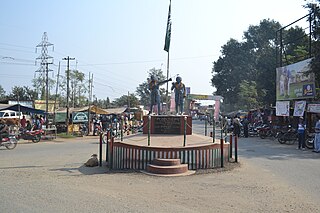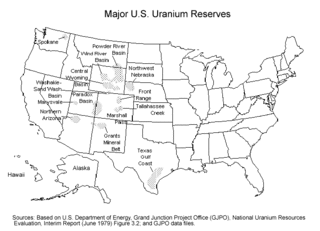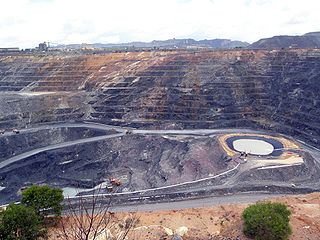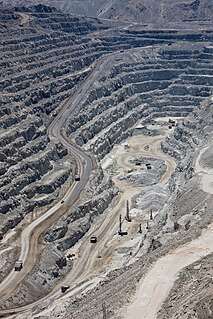Related Research Articles

The Ranger Uranium Mine was a uranium mine in the Northern Territory of Australia. The site is surrounded by, but separate from Kakadu National Park, 230 km east of Darwin. The orebody was discovered in late 1969, and the mine commenced operation in 1980, reaching full production of uranium oxide in 1981 and ceased stockpile processing on 8 January 2021. Mining activities had ceased in 2012. It is owned and operated by Energy Resources of Australia (ERA), a public company 86.33% owned by Rio Tinto Group, the remainder held by the public. Uranium mined at Ranger was sold for use in nuclear power stations in Japan, South Korea, China, UK, France, Germany, Spain, Sweden and the United States.

Uranium mining is the process of extraction of uranium ore from the ground. The worldwide production of uranium in 2019 amounted to 53,656 tonnes. Kazakhstan, Canada, and Australia were the top three uranium producers, respectively, and together account for 68% of world production. Other countries producing more than 1,000 tonnes per year included Namibia, Niger, Russia, Uzbekistan, the United States, and China. Nearly all of the world's mined uranium is used to power nuclear power plants.

Jadugora is a census town in the Musabani CD block in the Ghatshila subdivision of the Purbi Singhbhum district in the Indian state of Jharkhand.

Uranium mining in the United States produced 173,875 pounds (78.9 tonnes) of U3O8 in 2019, 88% lower than the 2018 production of 1,447,945 pounds (656.8 tonnes) of U3O8 and the lowest US annual production since 1948. The 2019 production represents 0.3% of the anticipated uranium fuel requirements of the US's nuclear power reactors for the year.

Nuclear power is the fifth-largest source of electricity in India after coal, gas, hydroelectricity and wind power. As of November 2020, India has 22 nuclear reactors in operation in 7 nuclear power plants, with a total installed capacity of 7,380 MW. Nuclear power produced a total of 43 TWh in 2020-21, contributing 3.11% of total power generation in India. 10 more reactors are under construction with a combined generation capacity of 8,000 MW.

Madawaska Mine (previously known as Faraday Mine) is a decommissioned underground uranium mine in Faraday, near the town of Bancroft, Ontario, which produced 9 million pounds (4,082 tonnes) of U3O8 concentrate, at an average ore grade of 0.1074%, during its two periods of production.
Peak uranium is the point in time that the maximum global uranium production rate is reached. After that peak, according to Hubbert peak theory, the rate of production enters a terminal decline. While uranium is used in nuclear weapons, its primary use is for energy generation via nuclear fission of the uranium-235 isotope in a nuclear power reactor. Each kilogram of uranium-235 fissioned releases the energy equivalent of millions of times its mass in chemical reactants, as much energy as 2700 tons of coal, but uranium-235 accounts for only 0.7% of the mass of natural uranium. While Uranium-235 can be "bred" from 234
U, a natural decay product of 238
U present at 55 ppm in all natural uranium samples, Uranium-235 is ultimately a finite non-renewable resource. Due to the currently low price of uranium, the majority of commercial light water reactors operate on a "once through fuel cycle" which leaves virtually all the energy contained in the original 238
U - which makes up over 99% of natural uranium - unused. Nuclear reprocessing is a technology currently used at industrial scale in France, Russia and Japan, which can recover part of that energy by producing MOX fuel or Remix Fuel for use in conventional power generating light water reactors. However, at current uranium prices, this is widely deemed uneconomical if only the "input" side is considered.

The Nuclear Fuel Complex (NFC) was established in 1971 as a major industrial unit of India's Department of Atomic Energy, as a nuclear plant also specializing in supply of nuclear fuel bundles and reactor core components. It is a unique facility where natural and enriched uranium fuel, zirconium alloy cladding and reactor core components are manufactured under one roof.

The mineral mining industry is a crucial piece of the Economy of Niger. Exports of minerals consistently account for 40% of exports.
Resources are classified as either biotic or abiotic on the basis of their origin. The Indian landmass contains a multitude of both types of resources and its economy, especially in rural areas, is heavily dependent on their consumption or export. Due to overconsumption, they are rapidly being depleted.

Radioactive ores were first extracted in South Australia at Radium Hill in 1906 and Mount Painter in 1911. 2,000 tons of ore were treated to recover radium for medical use. Several hundred kilograms of uranium were also produced for use in ceramic glazes.

The Honeymoon Mine was Australia's second operating in-situ recovery uranium mine, beginning production in 2011. It is located in South Australia and is 80 kilometres (50 mi) northwest of Broken Hill, New South Wales.

Uranium Corporation of India (UCIL) is a public sector undertaking (PSU), under the Department of Atomic Energy for uranium mining and uranium processing. The corporation was founded in 1967 and is responsible for the mining and milling of uranium ore in India. The firm operates mines at Jadugora, Bhatin, Narwapahar, Turamdih and Banduhurang

The Tummalapalle Mine is a uranium mine in Tumalapalli village located in Kadapa of the Indian state of Andhra Pradesh. Results from research conducted by the Atomic Energy Commission of India in 2011 made the analysts conclude that this mine might have one of the largest reserves of uranium in the world.

The Jaduguda Mine is a uranium mine in Jaduguda village in the Purbi Singhbhum district of the Indian state of Jharkhand. It commenced operation in 1967 and was the first uranium mine in India. The deposits at this mine were discovered in 1951. As of March 2012, India only possesses two functional uranium mines, including this Jaduguda Mine. A new mine, Tummalapalle uranium mine is discovered and mining is going to start from it.

Uranium mining in Namibia is of considerable importance to the national economy. In 2020, Namibia produced 11% of uranium worldwide, ranked as the 4th largest producer, behind Kazakhstan, Canada, and Australia.
The world's largest producer of uranium is Kazakhstan, which in 2019 produced 43% of the world's mining output. Canada was the next largest producer with a 13% share, followed by Australia with 12%. Uranium has been mined in every continent except Antarctica.

The Olympic Dam mine is a large poly-metallic underground mine located in South Australia, 550 km (341.75 mi) NNW of Adelaide. It is the fourth largest copper deposit and the largest known single deposit of uranium in the world. Copper is the largest contributor to total revenue, accounting for approximately 70% of the mine's revenue, with the remaining 25% from uranium, and around 5% from silver and gold. BHP has owned and operated the mine since 2005. The mine was previously owned by Western Mining Corporation.

Volcanic eruptions during the Precambrian era created very unusual geological conditions around Bancroft, Ontario, leaving it as one of only two uranium producing areas in Ontario. In the context of minerals and mining, the "Bancroft area" includes Haliburton, Hastings, and Renfrew counties, and all areas between Minden and Lake Clear.
References
- 1 2 3 "Turamdih Mine of UCIL". www.ucil.gov.in. Retrieved 2021-05-30.
- 1 2 3 4 "TURAMDIH URANIUM MINING PROJECT INAUGURATED | Department of Atomic Energy". dae.gov.in. Retrieved 2021-05-30.
- ↑ "Issues at Operating Uranium Mines and Mills - India". www.wise-uranium.org. Retrieved 2021-05-31.
- ↑ "Police cracks down on retrenched UCIL mine workers in Jharkhand". www.downtoearth.org.in. Retrieved 2021-05-31.